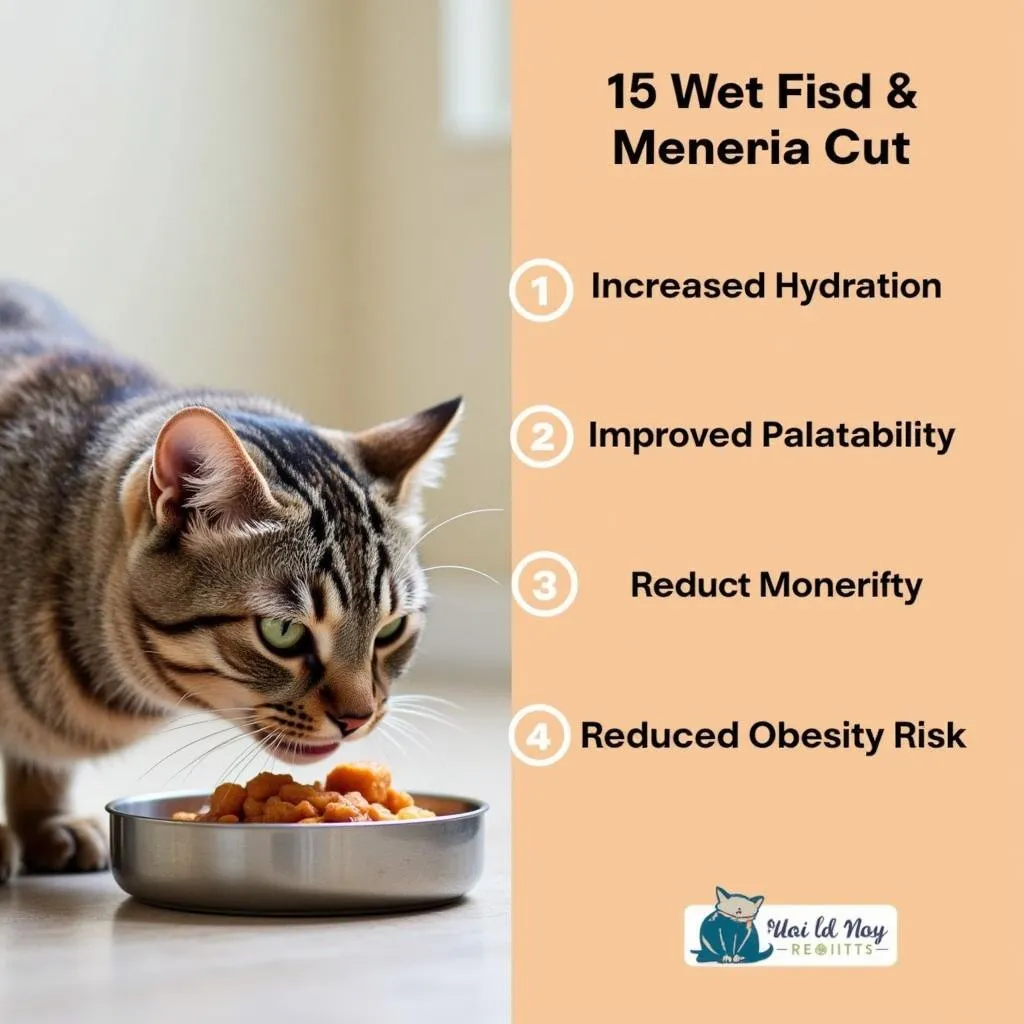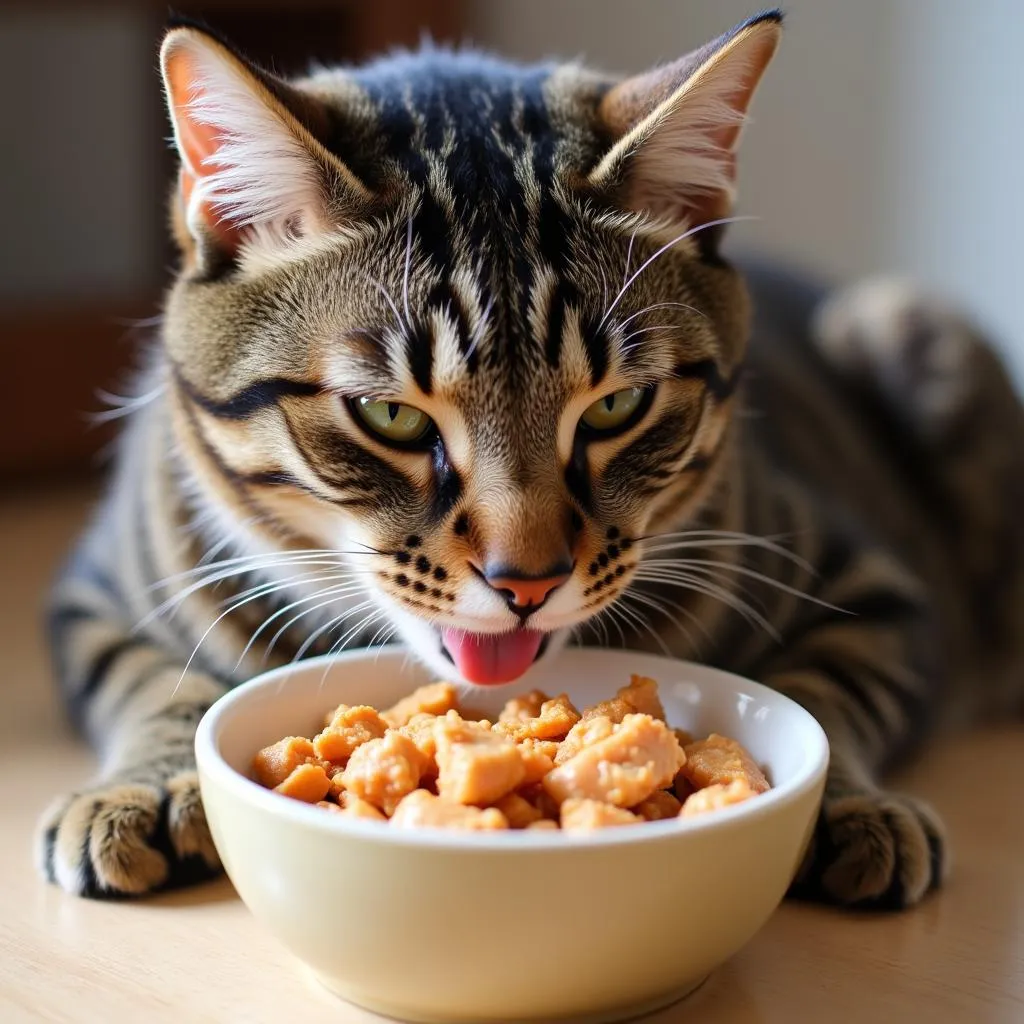Switching your cat to wet food can be a game-changer for their health and happiness. However, convincing a feline who’s used to the crunch of kibble to embrace a softer texture can be a bit of a challenge. If you’re wondering How To Get Cats To Eat Wet Food, you’ve come to the right place! This comprehensive guide will equip you with proven strategies, expert tips, and a sprinkle of feline psychology to help your picky eater embrace a healthier diet.
Understanding Feline Food Preferences
Cats can be notoriously picky eaters. Their preferences are often shaped by factors like early feeding experiences, texture preferences, and even their sense of smell. Understanding these nuances is key to successfully transitioning your cat to wet food.
Benefits of Wet Food for Cats
Before we delve into the “how-to,” let’s explore why transitioning your cat to wet food is a worthwhile endeavor.
- Increased Hydration: Wet food has a significantly higher moisture content than dry kibble, which is crucial for cats, especially those prone to urinary tract issues.
- Improved Palatability: The softer texture and enticing aromas of wet food often appeal to cats, making mealtime a more enjoyable experience.
- Reduced Risk of Obesity: Wet food typically contains fewer calories per serving compared to dry food, aiding in weight management.
- Enhanced Nutrient Absorption: The moisture in wet food can facilitate better digestion and nutrient absorption.
 Wet Food Benefits for Cats
Wet Food Benefits for Cats
Gradual Transition: The Key to Success
The key to transitioning your cat to wet food lies in patience and a gradual approach.
- Start Small: Begin by introducing a small amount of wet food alongside your cat’s regular dry food.
- Gradual Increase: Over a week or two, gradually increase the proportion of wet food while decreasing the dry food.
- Monitor Intake: Observe your cat’s eating habits closely, adjusting the portions as needed.
Tips to Tempt Your Feline Friend
If your cat is proving to be a bit resistant to change, try these proven tips:
- Warm It Up: Gently warming the wet food can enhance its aroma and make it more enticing.
- Top It Off: Sprinkle a few tasty toppers like tuna flakes, shredded chicken, or a sprinkle of catnip.
- Variety is Key: Experiment with different flavors and textures to find what tickles your cat’s fancy.
- Location, Location, Location: Ensure your cat’s feeding area is clean, quiet, and stress-free.
 Cat Enjoying Wet Food with Topper
Cat Enjoying Wet Food with Topper
Addressing Common Concerns
My cat is still hesitant. What should I do?
Don’t give up! Some cats may take longer to adapt. Try different strategies, consult your veterinarian, and remember that patience is key.
What if my cat has a sensitive stomach?
Opt for wet food brands specifically formulated for sensitive stomachs. These often contain easily digestible ingredients.
Can I mix wet and dry food long-term?
While not ideal, some cat owners choose to offer both wet and dry food. Ensure the overall diet is balanced and meets your cat’s nutritional needs.
The Bottom Line: Patience and Persistence Pay Off
Transitioning your cat to wet food is a journey that requires patience, understanding, and a dash of creativity. The benefits, however, far outweigh the challenges. By following these tips and remaining persistent, you can help your feline companion enjoy a healthier, happier life.
Frequently Asked Questions
Q: Can kittens eat wet food?
A: Yes, kittens can start eating wet food as soon as they’re ready for solid food, usually around 4-6 weeks of age.
Q: How much wet food should I feed my cat?
A: The amount varies depending on factors like age, activity level, and the specific food. Refer to the feeding guide on your chosen wet food brand.
Q: Can I leave wet food out for my cat all day?
A: It’s best to avoid leaving wet food out for extended periods as it can spoil quickly, especially in warmer temperatures.
Q: Is it normal for my cat’s poop to change after switching to wet food?
A: Yes, it’s normal to see a change in your cat’s stool consistency and odor when transitioning to wet food.
Q: My cat seems to prefer dry food. Should I be concerned?
A: Some cats may simply prefer the texture of dry food. If your cat is healthy and thriving on a balanced dry food diet, there’s no need to force the switch.
Looking for High-Quality Cat Food Options?
At Mina Cones Food, we understand the importance of nourishing your feline companions with the best. We offer a curated selection of high-quality cat food paws from reputable brands, ensuring your cat receives the optimal nutrition they deserve.
Check out our in-depth reviews of Nature’s Blend cat food, Earthborn Holistic cat food review, Country Naturals cat food, and Purina EN Gastroenteric cat food to find the perfect fit for your furry friend.
Need personalized advice on how to get your cats to eat wet food? Contact our team at Mina Cones Food. We’re here to assist you with any questions and help you make informed choices for your beloved pets. Reach out to us at 02437655121, email us at minacones@gmail.com, or visit us at 3PGH+8R9, ĐT70A, thôn Trung, Bắc Từ Liêm, Hà Nội, Việt Nam. Our dedicated customer support team is available 24/7 to assist you.